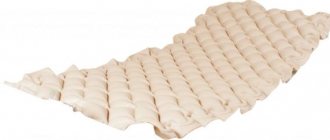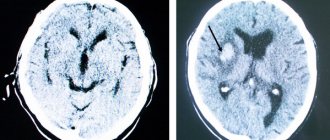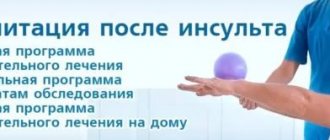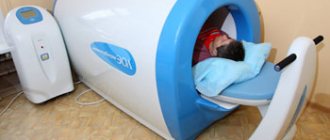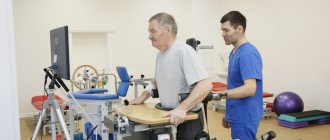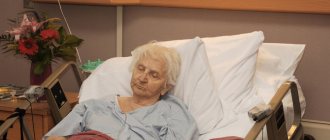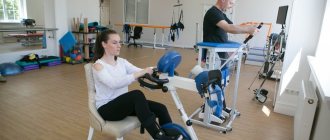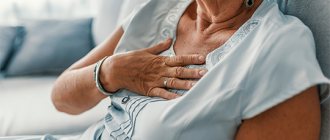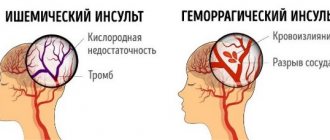Publication date: September 9, 2019
Stroke is a lesion of the central nervous system that develops as a result of a significant disruption of cerebral circulation. There are 2 types of strokes – ischemic and hemorrhagic. Ischemia is caused by blockage or prolonged spasm of the cerebral arteries. The hemorrhagic form is a consequence of hemorrhage due to rupture of a vessel. Ischemic stroke can develop gradually, while hemorrhagic stroke is characterized by a sharp increase in symptoms. Common causes of pathology are atherosclerotic changes in blood vessels and a significant increase in pressure (in particular, with hypertension). Recovery after a stroke on the left side is recommended to take place in specialized rehabilitation centers under the supervision of experienced specialists.
Symptoms of a left-sided stroke
Please note: Increasing headaches in the evening, which are not helped by analgesics, as well as a sharp increase in blood pressure and tinnitus, are one of the precursors of a hemorrhagic stroke. Common clinical signs of stroke development are also:
- profuse sweating;
- nausea;
- vomit;
- weakening of the pulse;
- loss of touch on the affected side of the body;
- general weakness;
- numbness of the limbs;
- articulation disorder;
- weakening or loss of vision in one eye (if the lesion is localized in the occipital lobe);
- loss of orientation in space;
- loss of coordination (if the pathological process has affected the cerebellum);
- difficulty swallowing;
- disturbance of the respiratory rhythm (if the focus is in the brain stem).
A left-sided stroke often leads to the development of paralysis of the right side of the body, which is manifested by the disappearance of all forms of sensitivity and a sharp change in muscle tone. Damage to the left hemisphere is characterized by motor aphasia (severe speech impairment). In relatively mild cases, the patient pronounces individual nouns (the symptom is called “telegraphic style”), and against the background of extensive damage, speech virtually disappears.
Important: Speech disorders significantly complicate the diagnosis.
When the lesion is localized in the left hemisphere, a disorder of logical thinking occurs. Patients are very often depressed if the neurons of the left temporal lobe are affected.
Difficulties in treatment and recovery after stroke with left-sided paralysis
Patients who have suffered a stroke, which resulted in left-sided paralysis, are passive in relation to rehabilitation measures, since their perception of their own body is distorted. They do not feel motor disturbances, do not strive for recovery, and the period of immobility is more protracted. With such indifference of the patient, rehabilitation is difficult, the recovery period after a stroke is too long, and the effectiveness of the measures is reduced because of this.
For cognitive impairment, nootropil, cerebrolysin, gliatilin, as well as some antidepressants without sedation, such as fluoxetine, imipramine, are prescribed.
Rehabilitation measures after a stroke consist of massages, therapeutic exercises, and physiotherapeutic procedures. Invaluable help can be provided by loved ones who will constantly encourage the patient to undergo treatment. A right-sided stroke requires the mandatory intervention of a psychotherapist.
Specifics of treatment of strokes of the left hemisphere of the brain
The main goal of stroke therapy is to restore damaged nerve cells. The basic principles of treatment are:
- urgency;
- complexity;
- phasing.
In clinical practice, there is the concept of a “therapeutic window”. This is a time period during which it is quite possible to fully or at least partially restore potentially reversible pathological changes in brain cells during a left-sided stroke. Its duration is from 3 to 6 hours, during which the patient must be admitted to the hospital.
Hemorrhagic strokes require surgery to remove the hematoma. Treatment of ischemic strokes involves active therapy to quickly restore cerebral blood flow.
Important: For still unknown reasons, nerve cells in the left hemisphere die more slowly than neurons on the right side, and recovery from paralysis on the right side is faster.
Of great importance is the establishment of the mechanism of development of acute cerebrovascular accident and identification of the main etiological factor in order to eliminate it as quickly as possible. In case of a stroke on the left side, recovery requires a timely (as acute symptoms subside) initiation of rehabilitation measures. To prevent the appearance of bedsores, muscle contractures and a number of other complications, the patient is recommended to undergo a complex of physiotherapeutic procedures, selective or general therapeutic massage, electrical stimulation, kinesiotherapy, and reflexology.
Please note: Kinesiotherapy creates favorable conditions for the victim’s rapid adaptation to physical activity. Massage is necessary to influence the receptor zones in order to obtain a general reflex response.
To improve the functioning of the central and peripheral nervous system, vitamin therapy (B vitamins and nicotinic acid - PP) is prescribed. To cope with depression and causeless mood swings, a patient recovering from a stroke on the left side needs the help of a specialist psychotherapist. It is advisable that psychotherapy sessions be carried out regularly, for which a stay in a specialized clinic or rehabilitation center is recommended. Treatment of speech disorders is carried out under the supervision of a speech therapist. If necessary, the doctor may prescribe medication. Some patients are advised to take drugs from the group of tricyclic antidepressants.
With a stroke on the left side, restoration of motor activity can begin 1-2 weeks after the episode of acute cerebral circulation disorder, and the patient requires absolute rest for the first days. If rehabilitation begins a month or more after the stroke, the prognosis worsens significantly against the background of asthenic-depressive disorders.
Please note: For left-sided lesions, approximately every third patient has a parallel development of right-sided sensory impairment and sensorimotor deficit, which significantly complicates the restoration of walking.
Afferent paresis is also often observed, which is characterized by difficulty in performing purposeful movements against the background of complete preservation of the strength and range of movements of the arms and legs. With the so-called thalamic syndrome after a stroke on the left side, which is accompanied by intense pain on the right side of the body, recovery may require the use of opioid painkillers, as well as medications that reduce paroxysmal activity of the central nervous system.
The text was checked by expert doctors: Head of the socio-psychological service of the Alkoklinik MC, psychologist Yu.P. Baranova, L.A. Serova, a psychiatrist-narcologist.
CAN'T FIND THE ANSWER?
Consult a specialist
Or call: +7 (495) 798-30-80
Call! We work around the clock!
Care after ischemic stroke
The patient should be in a bright, well-ventilated room, protected from extraneous noise, in which wet cleaning should be carried out regularly, at least 1-2 times a day.
The room should be ventilated several times a day so that the patient is not in a draft, and the average air temperature in the room is maintained at + 18-22 degrees.
Beds with sagging metal mesh cannot be used. It should be tightly stretched and covered with a dense mattress, for example foam rubber - the most hygienic and comfortable.
The caregiver is recommended to keep a diary in which to record indicators characterizing the patient: blood pressure, pulse, body temperature (it must be measured at least 3 times a day), the amount of fluid consumed (drinks, liquid dishes, fluid administered by infusion), the amount of excreted urine, frequency of bowel movements.
It is necessary to monitor the regularity of following the doctor's prescriptions.
To prevent congestion in the lungs, bedridden patients should do breathing exercises several times a day. The simplest type of breathing exercise is inflating a balloon.
In order to prevent bedsores, every 2-3 hours it is necessary to turn the patient over in bed, while performing a light massage of the skin on the back and sides of the chest, buttocks (stroking, rubbing). Special inflatable rings are placed under areas of the body where the risk of developing pressure sores is highest (heels, elbows, shoulder blades, buttocks, back of the head).
It is necessary to monitor the cleanliness of the patient's skin: regularly wash the patient's body with towels soaked in a weak soap solution, then wipe the skin dry. In some cases, camphor alcohol is used to cleanse the patient's skin.
After each meal, you need to clean your mouth of food debris.
Be sure to monitor the condition of the skin in natural folds (perineal area, groin and armpits, in women - under the mammary glands), as well as in fat folds. Areas of skin redness (maceration) should be treated with a gauze swab moistened with a pink solution of potassium permanganate or camphor alcohol.
If bedsores appear, you should consult a doctor about the rules of their treatment.
Symptoms
The following symptoms can help identify a right-sided stroke:
- the occurrence of headaches and a feeling of numbness in the left side of the body;
- paralysis of the left upper or lower limb. In this regard, when the patient tries to stretch both arms forward, a situation is observed where the left hand lags behind the right;
- patient complaints of dizziness, nausea and weakness;
- left-sided facial paralysis ;
- increased heart rate and pulse;
- decreased visual and hearing ability on the left side;
- the patient’s ability to independently rely exclusively on the right leg;
- impaired logical thinking;
- spasms ;
- at some point, a patient with right hemisphere damage may be found unconscious ;
- with this condition, patients report disturbed sleep, a state of exhaustion and a poor emotional state.
In a situation where a stroke has developed in an elderly patient, a coma is likely to occur, which will last no more than a day. If a person does not regain consciousness within the specified time, then the likelihood of acquiring disability increases at a tremendous rate every day.
Why does left-sided paralysis occur?
The brain is the central organ of the nervous system.
It consists of certain zones, each of which is responsible for individual body functions.
When any of these areas are affected, characteristic symptoms appear.
In the development of pathology, the principle of so-called reverse symmetry , i.e. when the right hemisphere of the brain is damaged, paresis of the left side of the body develops.
The right side of the hemisphere is responsible for creativity and the emotional component. When a stroke develops in the right hemisphere, symptoms such as impaired speech or the inability to express thoughts clearly appear, so identifying such a condition is much more difficult.
As practice shows, circulatory disorders in the right side of the brain, in which the left side of the body is paralyzed, occurs in 57% of diagnosed cases.
Important! The main cause of paralysis of the left side of the body is a violation of blood circulation in the right hemisphere of the brain. Parts of the brain cease to be nourished, as a result of which the central nervous system is affected.
What types of hematomas occur in hemorrhagic stroke?
Types of hematomas in cerebral hemorrhage or hemorrhagic stroke:
- Parenchymatous with the distribution of blood directly inside or under the membrane of the brain, with the formation of hematomas and with saturation of the nerve brain tissue. With such a hemorrhagic stroke, severe neurological deficits can form.
- Intraventricular with the effusion of blood into the ventricles of the brain, with tissue penetration and the formation of a hematoma. With this type, death especially often occurs within 3-5 days.
- Subarachnoid hemorrhages in the area between the arachnoid and pia mater of the brain.
- Mixed types of strokes, in which focal hemorrhages appear in different parts of the brain.
There is also a classification based on the volume of blood that forms hematomas: small - up to 20 ml, medium - in the range of 20-50 ml, large - from 50 and above.
What you need to know
The disease entails severe complications. The main condition is rest and minimal activity, this in turn contributes to the development of bedsores, pneumonia, thrombosis, loss of sensitivity, and mental disorders. Therefore, care for the patient must be taken responsibly. A comprehensive rehabilitation program is required:
- Drug treatment (drugs: nootropic, erythrocyte, platelet, vasoactive, angioprotective).
- Vitamins . Taking vitamins plays an important role in restoring the body and restarting metabolism. For a speedy recovery, you need to establish a balanced diet, and if necessary, consult a nutritionist to reduce body weight.
- Physiotherapy. One of the successful areas in the fight against the disease is physiotherapeutic procedures. Having diagnosed paralysis of the left side after a stroke, treatment with physiotherapy is simply necessary. With the help of modern equipment, it is possible to restore the functioning of nerve endings and make the remaining parts of the brain function. Achieve activity of the affected parts using artificially created impulses. The following physiotherapy procedures are effective:
- kinesitherapy;
- magnetic stimulation;
- physiotherapy;
- micropolarization;
- neuromyostimulation.
- Psychological support.
Treatment of disorders is a long process; relatives need to be patient and strong. The center’s specialists successfully cope with the most complex diseases. Modern equipment, successful experience, participation in world scientific conferences, the use of innovative methods, and most importantly, a sincere interest in achieving results - all this allows us to return to a full life, including patients who have suffered complete paralysis after a stroke.
Prognosis of paralysis
Is recovery possible if the left side of the body is paralyzed after a stroke?
The general life prognosis for such patients is favorable.
However, it is important to understand that the process of restoring lost abilities and returning to normal life is determined by several factors.
To begin with, what is important is the fact which part of the brain was affected by the pathological process.
Equally important is the volume of hemorrhage. The smaller it is, the less will be the degree of negative impact on the body. One of the key factors is the speed of first aid. And finally, the prognosis for improvement of the patient’s condition will depend on the chosen recovery methods.
Useful video on the topic:
Recovery and rehabilitation
In addition to massage and physical activity, the following manipulations will help restore the body’s functioning:
- have a good effect . In this way, sensitivity is stimulated, which speeds up the rehabilitation process;
- Speech therapy and breathing exercises help restore a person’s ability to express thoughts clearly. They consist in communicating with the patient as much as possible;
- Treatment with leeches demonstrates excellent results ;
- Dietary nutrition is important .
Therapy
Treatment of stroke includes basic and specific measures. To begin with, the patient is taken to the intensive care unit and undergoes a course of therapy, the purpose of which is to maintain basic vital functions, including blood circulation, breathing, and also eliminate swelling of the brain.
In the case of ischemic stroke, specific anticoagulant and thrombolytic therapy is carried out. In the case of hemorrhagic damage to the right side of the brain, the treatment, on the contrary, will be aimed at the use of drugs that lead to the formation of blood clots and closure of the bleeding.
Important! Rehabilitation involves undergoing physical therapy, a massage course, taking medications and various physiotherapeutic interventions.
Care and psychological assistance
Care for these patients will depend on their condition and presenting clinical picture. However, in any case, such people need to be provided with a bed with a raised base at the head. In addition, periodic rubbing of the skin is important for such patients. In order to avoid the formation of bedsores, the patient’s body position should be changed every 3 hours.
Already from 5-6 days after a stroke, you can begin the first measures in terms of rehabilitation. The speed and scale of restoration of lost functions will depend on their regularity and compliance with the patient’s condition. The patient’s chances for maximum recovery depend on how early rehabilitation is started.
If the patient’s loved ones have decided to independently care for him, then they should undergo a special course for the rehabilitation of such patients. However, if the condition of a person with a stroke is extremely serious, then it is better to entrust his care to a professional. In order for a person to be able to independently care for himself and gradually return to everyday life, he needs to re-master these skills.
Important! Psychological assistance is an essential component of recovery. The altered emotional state of such a person may be caused either by the stroke or by a reaction to it.
At a minimum, such a person should be provided with a comfortable and favorable psychological climate, communicate with him and avoid any disputes and conflict situations. If relatives are unable to establish contact with such a patient, then they can resort to the help of a professional psychologist, who should increase the patient’s motivation to recover.
